Eric Smith - a lifetime of cricket rollers
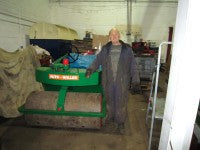 By rights, Eric and Marlene Smith, the husband and wife team behind Swillington Rollers, should be happily installed in a 'winter sun' resort, putting their feet up and generally enjoying a well earned retirement. Instead, here they are, on a cold day in January, showing me around their workshop on the outskirts of Leeds, a building that could almost double as a museum to cricket wicket rollers.
By rights, Eric and Marlene Smith, the husband and wife team behind Swillington Rollers, should be happily installed in a 'winter sun' resort, putting their feet up and generally enjoying a well earned retirement. Instead, here they are, on a cold day in January, showing me around their workshop on the outskirts of Leeds, a building that could almost double as a museum to cricket wicket rollers.
Eric possesses an almost stereotypical Yorkshire accent and, in conversation, will intersperse his words with 'lass' or 'lad' as the situation demands. "Here's a 4AR Auto-Roller. We put in new hydraulic equipment, renovate them and sell them on," Eric tells this lass, before whisking me on to the next machine, built by Stothert and Pitt Ltd. in the 1960s. His pride and joy is a Fowell roller, which had served the grass tennis courts of Wimbledon for forty years. "It was going to go in a skip," he says, in horror. A magnificent Barford and Perkins 3A Motor Roller from the 1930s was saved from a similar fate when Eric rescued it from a scrap yard ten years ago. Having restored it to its former glory, he donated it to the Shildon Locomotion Museum, near Consett in Co. Durham.
Ten minutes, a mug of coffee and two chocolate biscuits after my arrival, I'm sitting on Eric's new machine testing its manoeuvrability. "Go on, it's easy lass," he 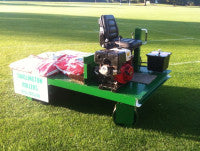 urges, and he's right. Weighing half a tonne (the weight increases to one tonne according to the flatbed load and thickness of the steel used for the rollers), the 'Supreme' Swillington Roller glides forward, back and around with the lightest touch of the lever.
urges, and he's right. Weighing half a tonne (the weight increases to one tonne according to the flatbed load and thickness of the steel used for the rollers), the 'Supreme' Swillington Roller glides forward, back and around with the lightest touch of the lever.
A combined roller and flatbed in one, the new vehicle is the result of one of those simple ideas, which seem so obvious you're amazed that nobody's thought of it before. "Some cricket grounds cover six to eight acres and, in a lot of cases, especially in the smaller clubs, one groundsman will be doing everything," Eric explains. "With this machine, he can put everything he needs on the back - loam, line marking equipment, water, even a small mower."
In appearance, it bears no resemblance to any other cricket roller currently available in the UK, apart from the traditional green paint job. It is, basically, a flatbed with a seat and an engine, atop two small diameter rollers. And it looks bullet proof! As if to show the sturdiness of his new machine, the restored Fowell roller is sat on the back of one of the new models.
Customers can choose rollers of varying thickness according to their anticipated flatbed loads, which will affect the overall weight on the ground. Eric's customer on the Isle of Man has ordered the lightest rollers with steel 8mm thick, as he is intending to use the flatbed facility to the full. Headingley and Dulwich College, who already have a 'Supreme' machine, chose the standard steel rollers at 10mm. With a 9hp Honda engine, full hydraulics and a top speed of three miles per hour, the new machine is light enough for pre-season rolling, but the weight can be increased by loading the flatbed as the season goes on.
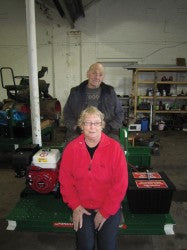 "Groundsmen are the heroes of our sports fields, especially when it comes to cricket," Eric maintains. "Often, I've said to the smaller clubs, 'just pay for delivery and give me the rest when you get your grant', but, nowadays, there isn't the grant money available."
"Groundsmen are the heroes of our sports fields, especially when it comes to cricket," Eric maintains. "Often, I've said to the smaller clubs, 'just pay for delivery and give me the rest when you get your grant', but, nowadays, there isn't the grant money available."
However warm and generous an individual might be (and, having met Eric and Marlene, I can personally vouch for the fact that the couple are both), fate is indiscriminate in its dealings as, in 2007, Marlene was diagnosed with breast cancer. Having been married for over forty years and raised two sons during good times and bad, Marlene is definitely the 'power behind the throne.' She reacted to the news in a matter of fact fashion, opting to have a mastectomy. "After the biopsy results, I was told that lumps are graded from one to five, and my lump was a grade four," she remembers. "I had the choice of having a mastectomy or not, and I told the specialist to 'take it all off.' It's my life and my body."
Having dealt with the crisis single handed up until this point, once home and undergoing chemotherapy, Marlene needed the support of Eric and her sons who, she confides, had both been in denial. "My GP told Eric that I couldn't fight the disease on my own," Marlene says and, after that moment, they tackled her illness together. Three years ago the couple downsized to a bungalow, and the move has proved a resounding success.
Marlene's health gradually improved and she began fundraising for Macmillan Nurses. Last year she helped raise £11,000; £2,000 coming from roller spare parts sold by Eric. He is immensely proud of his wife, and they are both looking forward to the day, hopefully this June, when Marlene will be given the all clear.
A year after the move, Eric, with the help of his eldest son Simon, began work on his new roller. "I thought, I'll just get myself together and I'll make something," he recalls.
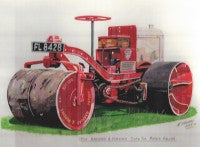 Engineering is in Eric's blood. His father worked at Fowlers in the days when this whole area of Leeds was dedicated to engine manufacture, housing not only Fowlers, but Greens, McLaren's and Hunslets. "Dad was a part of it," says Eric. Once the war started, Mr. Smith senior became part of the effort to keep up moral. "I grew up on the fairgrounds of Lancashire and Liverpool. Most of them had shut down, and it was important to keep the ones that were left running. Dad was their resident engineer," Eric explains. "I went to any number of different schools."
Engineering is in Eric's blood. His father worked at Fowlers in the days when this whole area of Leeds was dedicated to engine manufacture, housing not only Fowlers, but Greens, McLaren's and Hunslets. "Dad was a part of it," says Eric. Once the war started, Mr. Smith senior became part of the effort to keep up moral. "I grew up on the fairgrounds of Lancashire and Liverpool. Most of them had shut down, and it was important to keep the ones that were left running. Dad was their resident engineer," Eric explains. "I went to any number of different schools."
The new roller gets its name from a Mrs Deacon who ordered a showman's traction engine from Fowlers during the time that Eric's dad worked there. It was one of the first to be built with a chrome spiral trim. Mrs Deacon insisted that the trim was the wrong height and had to be trimmed down. Only when this had been accomplished would she accept her new machine. "It's the 'Supreme' engine," she said, little knowing that the name would be resurrected in 2011.
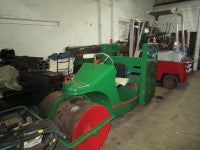 Gone are the days of huge hand rollers. "Times have changed and standards have gone up," Eric says. "I've watched old men struggle on cricket pitches for years. I remember one guy (he's ninety years old and retired now), at Sherburn cricket club, using the front roller from a steam engine. Another club actually used a15 tonne machine up and down the wicket!"
Gone are the days of huge hand rollers. "Times have changed and standards have gone up," Eric says. "I've watched old men struggle on cricket pitches for years. I remember one guy (he's ninety years old and retired now), at Sherburn cricket club, using the front roller from a steam engine. Another club actually used a15 tonne machine up and down the wicket!"
Eric's 'Supreme' roller is the result of years of experience and a sound knowledge of the needs of cricket club groundsmen. Now that he has produced his own design, do the couple have any thoughts on retirement? "Eric will never retire" says Marlene, and perhaps that's just as well. Judging by the reaction to this first new roller to come out of Leeds for over forty years - Headingley's Head Groundsman, Andy Fogarty, has been quoted as saying, "It's a good, compact machine" and "it's like two rollers in one" - the Smith family are going to be too busy.
Mike Atherton and the team at King Williams College would like to offer their thanks to Eric and Marlene Smith of Swillington Rollers.
We made initial enquiries with a number of companies regarding the purchase of a new roller in November 2011, with a view of having one in place for the start of February 2012. From the initial conversation with Eric, it was clear that it was he that we wished to do business with.
Once the decision had been made with regards to whom we would be dealing with, a decision had to be made as to which roller to buy. We were moving from an Auto Roller that had served us well for 41 years. Eric gave us three options - a replacement Auto Roller, a Stothert and Pitt, or his new 'Swillington Supreme' - Eric offered his own opinions based on his vast experience. The topic was then discussed at length with the rest of the team at King Williams College - we made a joint decision that the 'Swillington Supreme' was the roller for us, this based on many factors, first and foremost the Health and Safety compliance of the machine, which is now a fundamental part of the process when identifying any new machine for all groundsman nowadays. We also liked the ease of use, access to all components for ease of maintenance, ease of getting on and off the machine, and also the ease of effective and thorough cleaning, which is a critical, but often overlooked factor - these points are what I like to call the 'usability points', and I always factor these in when looking at any machine.
Further to the 'usability points', we then had to look at the actual effectiveness of the machine. Through speaking to Eric, and also Simon Smith, we knew that the roller, when fitted with 10mm thick rollers exerted the same ground pressure as the Auto Roller; however, we opted for the 8mm thick steel rollers which reduce the weight of the roller to allow us more versatility, as we can still ballast the roller accordingly if we wish to do so. Speaking of the versatility, the 'truck style' back was a major contributing factor in our decision, as with having a number of squares dotted all over our grounds, it will be very beneficial to be able to load everything we need on the back of the roller to minimise wasted transport time. With this in mind, we also had a small winch fitted to the back of the roller to aid with loading mowers onto the back of the roller.
Having discussed all of the above with the team, we confirmed the order in December, and as originally planned, the roller arrived on Feb 1st, 2012. During their time with us, Eric and Marlene provided us with first class service, imparted much wisdom on us, and also entertained us thoroughly. Having taken the time to show Eric and Marlene around the island, and spent time with both, I can safely say that we made the right decision.
Mike Atherton
Head Groundsman
King Williams College
